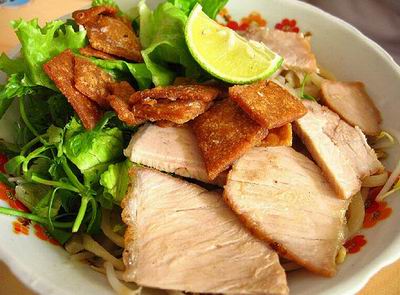Cao Lau Noodles: Pride of Hoi An

Until the 17th century, Hoi An was the primary trading town in Central Vietnam. Tourists on the Saigon-Hanoi route usually stop over the town popular for its historical significance. On the other hand, traders from such countries as Denmark, China, Japan, and India purposely come to the place to conduct their business and other trading transactions.
While waiting for their ships to be unloaded, traders would rest on the second floor of a riverview restaurant and sip on a steaming cup of cao lau noodles. And while the trading and shipping industry have long since moved to Da Nang, cao lau is still the pride of the local residents of Hoi An. Because while other establishments attempt to copy the recipe, it is only in Hoi An where the authentic dish can be truly tasted and appreciated.
Cao Lau noodles stands out from all the other versions with its texture. Unlike the other noodles, the Hoi An original is much firmer and chewier. Cao lau noodles resembles Japanese udon, while all the other Vietnamese attempts look and taste like pho. Unlike the other recipes too, cao lau noodles of Hoi An is served with very little broth whch is seasoned with cilantro, basil, mint, and sometimes chili peppers and lime. What makes cao lau noodles furthermore significantly different from its competitors is that it is served with salad greens and bean sprouts, and topped with thinly-sliced pork slices and deep-fried croutons, something which other establishments fail to do because of their cost-cutting strategy, sacrificing the most important factor of quality along the way.
But the real secret to Cao Lau Noodles of Hoi An is in the water. Authentic cao lau noodles is made with water drawn from and only from the ancient Cham wells, concealed around Hoi An and Quang Nam Province. The noodles are pre-soaked in the well water as well as in lye made from wood ash found in one of the (eight) Cham Islands (around 10 miles outside of Hoi An).
Cooking real cao lau noodles is a daunting task. That is why even local residents prefer eating the in-demand dish prepared by the professionals themselves. Especially for tourists who love adventure both in sightseeing and food, the street vendors and outdoor market, specifically on the east side of Bach Dang Street, is the best place to find authentic cao lau noodles. Restaurants are not reliable sources of the Hoi An specialty, but some who operate their own cooking school have started serving the authentic dish as part of their menu.
Despite the “drama” around this food, cao lau noodles is surprisingly cheap at just below $2 per bowl. It is best eaten during breakfast or lunch when the noodles are most firm. Moreover, there are other specialties tourists and locals alike can enjoy when in Hoi An: White Rose, Hoi An pancakes, and fresh beer.









